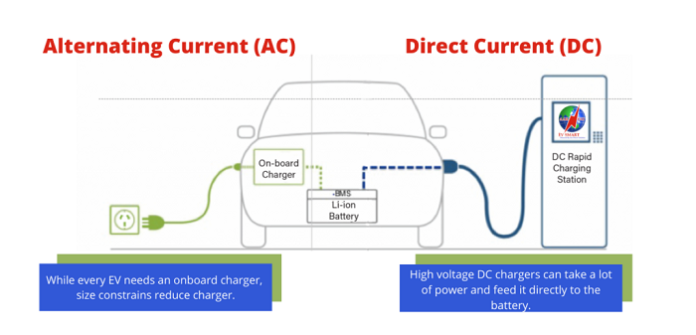There is a ton of terminology floating around regarding electric vehicle (EV) charging. You may have learned about different EV charging “levels,” as well as terms like fast or rapid charging. Another important factor to consider for EV charging is the power current. Electric vehicle charging stations use both alternating current (AC) and direct current (DC) to power EVs. Read on to learn about the differences between both types of electric power, as well as the pros and cons of each.
AC vs. DC Power
Near the turn of the 20th century, Thomas Edison and Nikola Tesla were developing the types of electric power we use today. Edison championed DC power, which started as the standard electricity in the United States. Tesla established AC electricity to combat some of the obstacles DC presented.
DC Power
DC electricity is current that constantly runs in one direction. This is the power found in fuel cells, solar cells and batteries. While DC power was mostly supplanted by AC for power grid purposes, it has made a resurgence lately due to many modern technologies running on DC power. Computers, LEDs and electric cars are technologies that rely at least in part on DC electricity.
AC Power
Even though Edison tried to discredit the safety of AC electricity, the ability to more easily alter voltages using a transformer led AC power to become the power grid standard for much of the world. AC electricity is current that reverses direction many times per second. In the United States, AC power reverses direction 60 times per second.
While both AC and DC power have a place in our world today, each has its benefits and drawbacks. Fortunately EV charging stations use both types to power EVs, and deciphering which best suits your needs depends on many factors.
AC and DC Power Pros and Cons
Because so much of our power grid relies on transporting and transforming AC power, it is a great place to start with regard to EV charging. AC power does have some limitations such as speed and stability. Conversely, DC infrastructure is less prevalent, but with powerful modern batteries such as the ones found in EVs, DC electricity is finding a place in our modern world.
AC Pros
Ironically, AC power eventually became known as the safer form of electric power, at least in terms of power grid applications. The ability to easily alter voltages using transformers is the reason we do not have extremely high voltages running in our homes and businesses. AC power is also readily available, and charging stations can often easily use existing power infrastructure. Additionally, AC power is considered safer for frequent use when charging EV batteries, as many EV manufacturers recommend limiting the frequency of DC charging.
AC Cons
Because the current is alternating, this type of power can experience electricity loss as it travels distances. This is another reason the power grid uses transformers: By raising the voltage extremely high, power companies can send power great distances and not experience severe electricity loss. The AC also leads to a slower transfer of power, at least at the lower voltages we use in day-to-day applications. For EVs, this means AC charging is slower compared with DC charging.
DC Pros
Edison would likely be thrilled that DC is back in favor today. DC power is more stable due to the consistent flow of current, and as technology develops, companies are becoming better able to transfer DC power over distances with even less electricity loss than AC power. DC power is also a faster form of electricity as it relates to EV charging stations.
DC Cons
The primary drawback of DC power is the corresponding lack of infrastructure. Because the power grid still relies primarily on AC power, DC charging is less widespread, especially in smaller-scale applications. However, thanks to companies like EV Connect, DC charging has never been more accessible. As previously mentioned, there is some debate surrounding how frequent EV drivers should use DC power to charge their vehicles, and most manufacturers recommend against daily DC charging.
EV Charging “Levels” and Power Current
There are three commonly referred to levels of EV charging. The levels (1, 2 and 3) mostly correspond to the speed with which the charger can fill an EV battery:
Level 1 (AC)
The first level is essentially just the power we use in our daily lives: AC power outlets in homes and businesses can power your EV. Level 1 power is inexpensive and accessible; however, this low voltage AC power is the slowest way to charge a vehicle, and for most drivers who regularly use their EV, it is not a viable way to charge.
Level 2 (AC)
AC level 2 charging is the most common form to power EVs. This power still relies on the standard AC, but uses a transformer to raise the voltage and increase the speed with which level 2 can top up an EV. Level 2 charging is a great option for homes, multi-unit dwellings and other businesses, as the speed of these chargers is effective for most EV drivers.
Level 3 (DC)
Sometimes referred to as “fast charging” (DCFC) or “rapid charging” (DCRC), level 3 charging is the fastest way to power an EV. Though it requires more initial setup cost and construction, the stability of DC power in level 3 charging can top up an empty EV battery in as little as 30 minutes. Level 3 chargers are a great option for fuel stations along major routes like interstates.
Conclusion
While the development of electricity began with a heated battle between AC and DC power, the use of both continues today. Fortunately for EV drivers, there is no need to argue because EV charging infrastructure benefits from both AC and DC charging stations. Be sure to check out all of EV Connect’s charging solutions!








